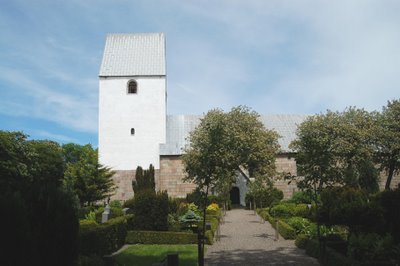
Hillerslev church , Thy, 8 km north of Thisted.
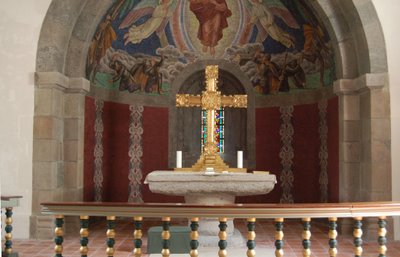
The Romanesque Communion table, a very heavy monolitplate rests upon a heavy circular midpillar. The altar piece is since 1920 a gilt wooden cross in connection to frescoes in the apse behind it.
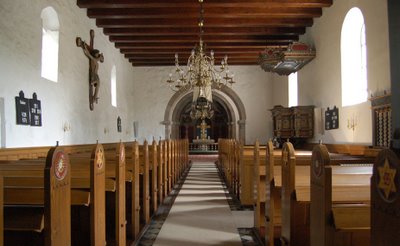
Interior
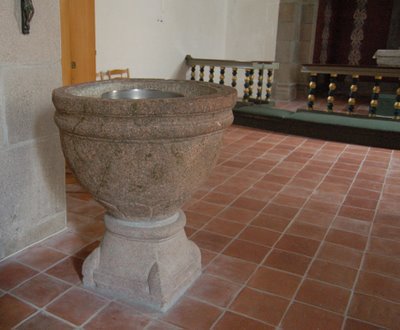
The Romanesque granite font is a Thybo-type.
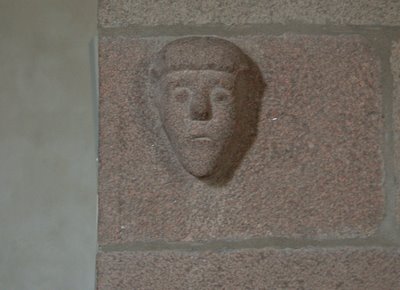
In choir a relief head
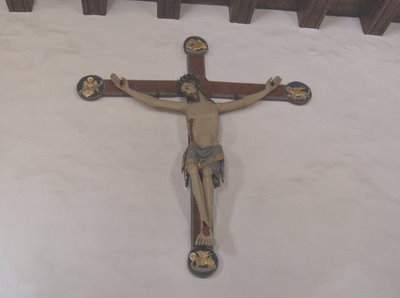
High Gothic crucifix in choir from 1350-1400, one of the best wooden sculptures of the district.
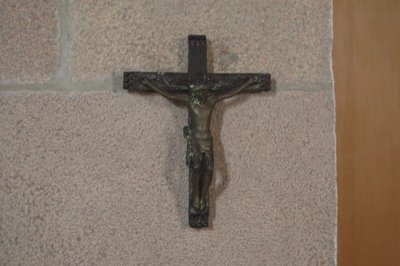
The brass crucifix was once a coffin crucifix and later a part of an earlier altar piece. A side wing and some figures from this late Gothic altar piece (ab. 1475-1500) are preserved. This is now placed upon the wall in the tower room together with a heavy Baroque altar piece from ab. 1700. A choir grating from 1698 with figures and reliefs is placed by the south door.
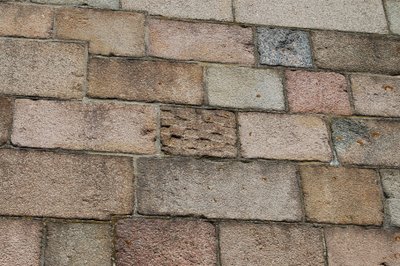
Chessboard
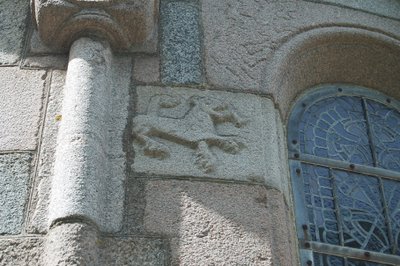
A lion i relief with a human leg in the mouth, above is scratched another lion in the stone.
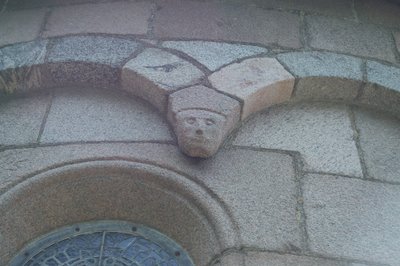
A human head (bishop?) upon the apse

Animal head upon the apse .
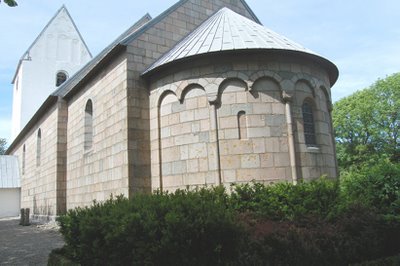
The apse
Hillerslev Church has a Romanesque apse, choir and nave, a late Gothic tower and a new porch. The Romanesque part is built in granite ashlars. The richly decorated apse, (changed in 1886), is split up in five bays with slender pillars. Above every bay is different ornamented corbels of human and animal heads. The rather large east window has in the monolit coverstone a carved lion, and upon the upper frame stone to the south is a relief of a lion with a human leg in its mouth. In the next archades were lesser windows which are now walled-in. The choir has kept its north window with a curved coverstone, and in the north wall of the nave are kept two re-stored windows. Both doors are seen, the south door is in use while the north door is walled-in. Upon an ashlar in the north wall of the choir is a protruding relief head, and in the walls in general are several stone mason fields, among those a chess board ashlar. In the top of the north wall of the choir is placed a fragment of a stone lamp- a small ashlar with three round hollows.
The inside of the church has beamed ceilings and in the choir arch with profiled kragsten is a relief head. The late Gothic tower from ab. 1500 is built in re-used ashlars and yellow monk bricks. In the tower room, which has a pointed arch to the nave, was in 1886 placed a cross vault. A stairhouse on the northeast corner with a spindeltrappe(spiral staircase) and an entrance from the nave leads up to the middle storey. The outer walls of the tower are re-walled. The west gable is probably from 1687, while the east gable is from the second part of the 1800s.
The Romanesque granite communion table has a very heavy monolit top, resting upon a large round middle pillar. As an altar piece is since 1920 a gilt wooden cross in connection to a frescoe in the apse. From a late Gothic altar piece from ab. 1475-1500 is preserved a side wing and some figures. The piece is now placed in the tower room together with a heavy Baroque piece from ab. 1700, similar to the piece in Vesløs Church from 1701. An earlier altar crucifix in brass, originally a coffin crucifix , hangs in the choir arch. A Romanesque granite font in of the Thybo-type. A south German baptismal basin from ab. 1575. A choir grating from 1698 with figures and reliefs placed by the south door. A fine High Gothic choir arch crucifix from ab. 1350-1400, one of the best wooden sculptures of Thisted district, restored in 1930. A Renaissance pulpit from 1645 by cabinetmaker Jens Nielsen from Snedsted with naive archade reliefs. A couple of archade fields from the pews from ab. 1650 are kept. The church ship from ab. 1750-75. Church bells 1) 1641 by Claus V(oillardi?); 2) 1783, by D.G. Herbst.
Gravestones: 1) Romanesque granite gravestone, shaped like a gravetree, decorated with greek crosses; 2) Romanesque double-gravestone in granite, ab. 1200, with reliefcarved coat of arms and cross and the names "Thorchil" and "Mergret, along the edge a crumbled runic inscription, probably a prayer to Virgin Mary; 3 and 4) Romanesque grave stones with relief crosses, but without inscriptions.
Names in the Middle Ages and 1600s: Hillerslev (*1231 Hyldæslef, 1608 Stuor Hillersløff); Skovsted *1435 Skoffzsteth, *1449 Skowesteth); Kelstrup (1458 Kilstrop); Brund (1600 Brondt); Lille Hillerslev (1602 Lilhellersløff, 1608 Nør Hillersløf); Kanstrupgaarde (*1491 Kanstrup); Kortegaarde (*1491 Kortegaardt); Jensbygde (*1497 Jensby); Oddershede (1600 Odershiede); Kilsgaard (*1559 Kieldtzgaardt);
Kelstrup is mentioned earliest in 1458, plus in 1466 ("Kiellstrup") and again in 1497 (Kielstrop"), when the noble man Mogens Kirt sold a farm in the village to his brother Henning Kirt.
Hillerslevhus Manor was earlier a royal castle. By inheritance 1263 Hillerslev and other estate went to Erik Plovpenning's daughters Jutta and Agnes. Hillerslevhus is probably identical to the 'Hyldæslef' , which is mentioned in Valdemar's Jordebog (main part) from 1231. Among the Jute 'kongelev' (king's estate) Valdemar's Jordebog mentions 'Hyldeslef'. Hillerslevhus was in 1460 handed over to Niels Strangesøn Bild . 1423 Henrik Gyldenstierne is mentioned as høvedsmand (army chief) at the castle, which probably was destroyed during the following peasant revolt.
North of Hillerslev village (500 m north of the church) is Hillerslevhus Voldsted (rampart) in the meadow, surrounded by steep banks. It is very levelled now, but in spite of the destruction it is easy to see how it might have looked. Upon the banks were only place for a single house or tower. In a minor excavation were found rests of a pile bridge between the banks. The banks were built up in earth and limestone upon a layer of branches placed upon the original boggy ground. It seems that the buildings upon the banks were timber, but 'munkesten' (early bricks)were found too. The farm belonging to the castle was probably situated upon the higher land area, as it is mentioned in a priest-report from 1638.
Kortegård was in 1491 owned by the Børglum bishop.
In the parish is mentioned in *1483 a farm Kringe; in ab. 1600 the farms Overgård (1600 Offrgrdt) and Dal 1600 Dall); in St. Hillerslev also the farms Keldtoft (1600 Kieldtofft), Ved Kirken (1688 Ved Kirchen) and Hove (1606 Hoffue) south of the church.
Listed prehistorics: 14 hills , among those the large Tinghøj (1638 Gamel Thinge hye) and Styvelshøj and 3 Galgehøje on the hillside south of Hillerslev; plus the long hill Kløvenhøj. - Demolished or destroyed: two long dolmens and 52 hills. - In the southwestern part of the parish are found two Iron Age settlements with house sites.
South of the church was a sacred well.
Source: Trap Danmark, Thisted amt, 1961
photo 14 April 2006: grethe bachmann
No comments:
Post a Comment